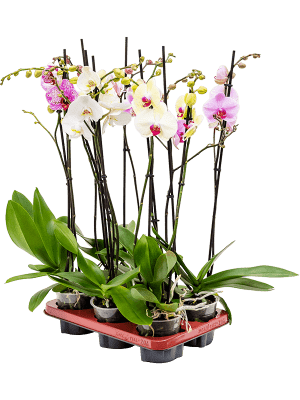
Phalaenopsis mix 6/tray
2-Branches 16+
4PHALBP40
Origin
The Leea guineensis 'Burgundy', often referred to as the West African leea, has its origin in the tropical and subtropical areas of West Africa. This species is indigenous to countries including Niger, Nigeria and Cameroon. The plant has been used in this area for centuries for medicinal purposes, including for the treatment of hepatitis and malaria. Despite its origin in West Africa, the plant has managed to adapt to various climates and grows in various parts of the world today.
Characteristics
The Leea guineensis 'Burgundy' is a deciduous shrub that can grow up 3 to 4 metres high in its natural environment. The plant displays large, oval leaves with a deep burgundy colour, which has earned it the term 'Burgundy'. Also characteristic are the pinkish-red flowers that the plant produces in the late spring and early summer. In addition, the plant has a striking bark that stands in sharp contrast to the deep red leaves.
Care
The care of the Leea guineensis 'Burgundy' requires relatively little maintenance. The plant prefers light, but not direct sunshine and thrives best in well-drained soil. As a subtropical plant, it also prefers higher humidity. The plant has moderate water requirements; it is better to keep its soil slightly moist rather than soaked. Too much water can cause root rot, a common disease with this species.
| Phone NL | +31 885 014 000 |
|---|---|
| Phone NGC | +31 885 014 014 |
| Phone FR | +33 (0)130 760 344 |